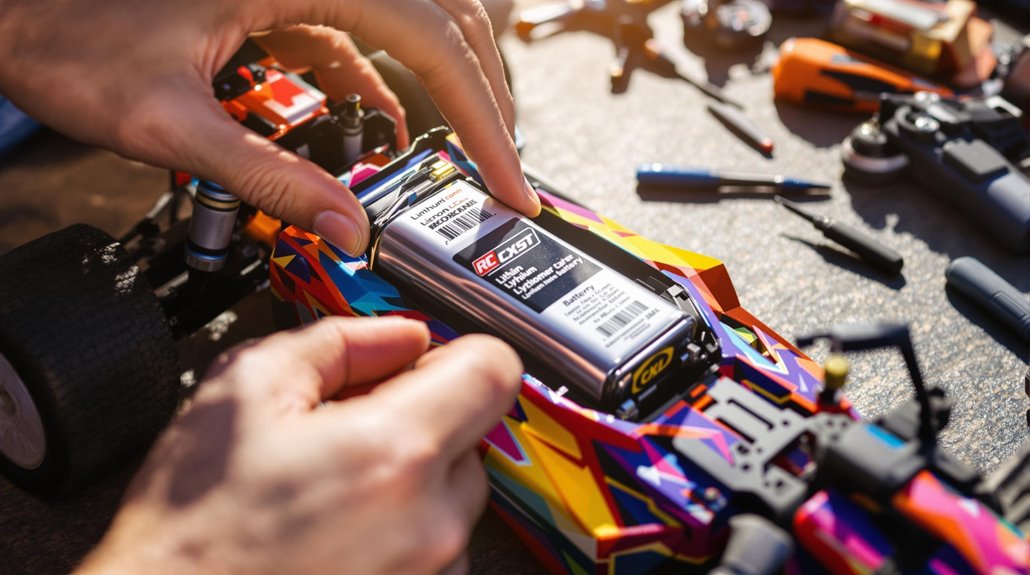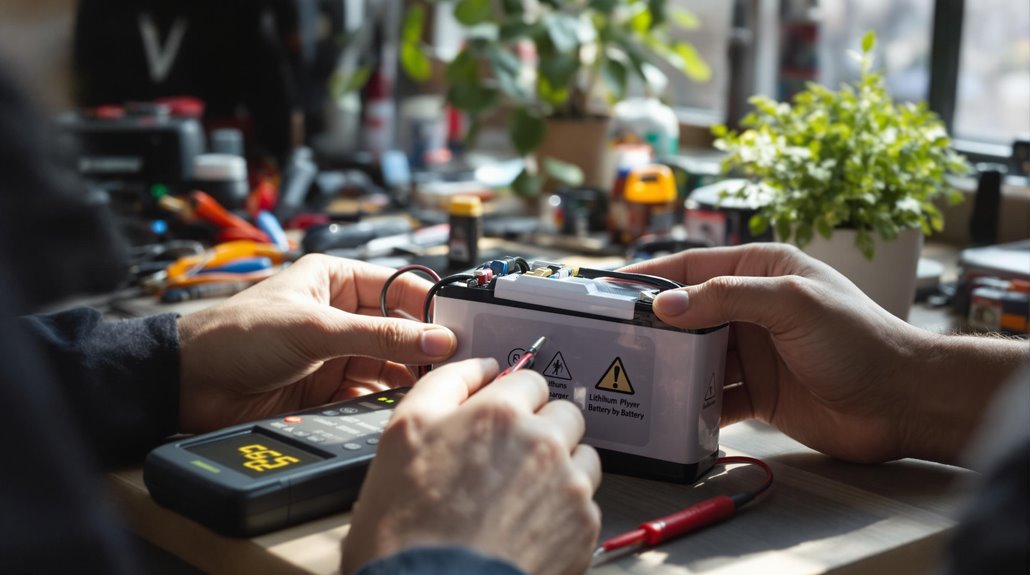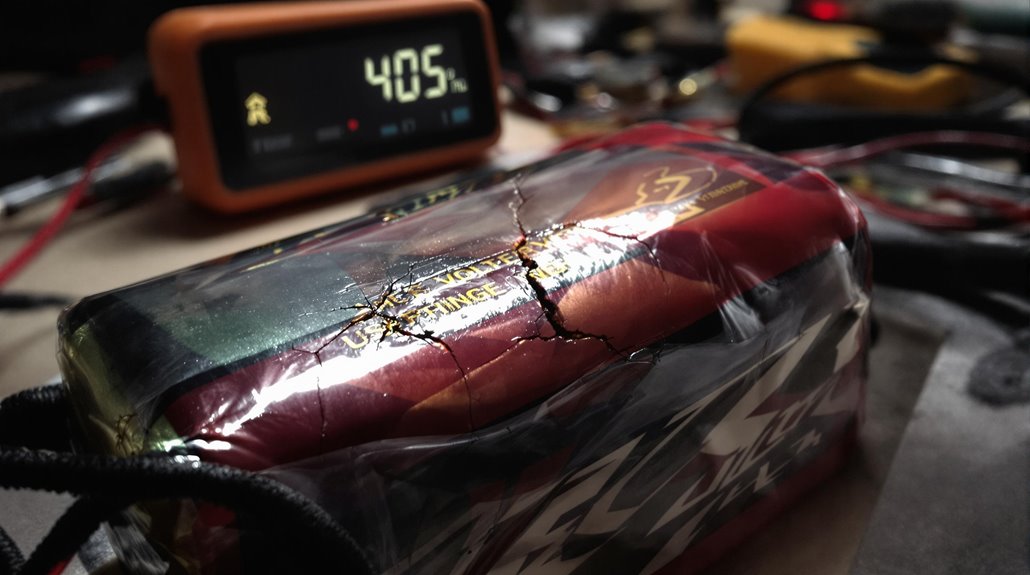How Can RC Enthusiasts Extend Battery Life?

To extend your RC battery life, start by assessing its performance and consider upgrading to higher capacity options like 6.4V 1600mAh batteries. Ensure compatibility and avoid connecting in series to protect your components. Use a charger designed specifically for your battery type and maintain it in a temperature-controlled space. Remember to avoid fully discharging your batteries; keeping them between 20-80% charge is key.
Store them at 50% charge in a cool, dry place and keep contacts clean. These steps can significantly enhance your battery's longevity—there's plenty more to explore to optimize your RC experience.
Key Takeaways
- Choose higher capacity batteries, like 6.4V 1600mAh, to significantly enhance runtime and overall performance.
- Regularly monitor battery voltage and maintain a charge level between 20-80% to prolong lifespan.
- Avoid fully discharging batteries and allow a cooldown period of 15-20 minutes before recharging.
- Charge batteries using a compatible charger in a temperature-controlled environment (20-25°C / 68-77°F).
- Keep battery contacts clean and store batteries at 50% charge in a cool, dry place to prevent deterioration.
Assessing Original Battery Performance
When you assess the performance of your original battery, you'll quickly notice its limitations. The 6.4V Ford Raptor truck's battery, with a capacity of just 350mAh, restricts your running time to a mere 15 to 20 minutes. This short runtime highlights a crucial point: a higher capacity battery is essential for extended playtime. Cheaper batteries (NiMH) cost under $30, but opting for lithium-polymer batteries with higher mAh values can significantly improve performance and runtime.
To effectively assess battery performance, start by monitoring the voltage and runtime during your RC adventures. Understanding these metrics helps you gauge how well your current battery meets your needs. If you find that your truck's performance isn't living up to your expectations, it's time to consider upgrades. Knowledge of your original battery's specifications is key in this process.
By knowing the mAh rating and overall performance characteristics, you'll be able to identify compatible replacements that can enhance your RC battery experience. Opting for a higher-capacity battery not only extends the playtime but also maintains safe operation within your vehicle. So, dive into assessing battery performance; it's the first step toward improving your RC experience!
Choosing the Right Replacement
Finding the right replacement battery can make all the difference in enhancing your RC experience. When choosing a replacement battery, consider options with larger capacity, like a 6.4V 1600mAh battery, which can significantly extend your runtime compared to the original 6.4V 350mAh battery. It's crucial to ensure the new battery type, such as LiFePO4, is compatible with your RC vehicle. This type offers advantages like improved safety and longer cycle life.
Additionally, check the dimensions and weight of the replacement battery. You want to confirm it fits snugly in the original battery holder without affecting the vehicle's balance. If you're looking for maximum playtime, consider connecting the original and new batteries in parallel. This setup maintains the voltage at 6.4V while increasing the total capacity.
Lastly, always research reputable brands and read reviews to ensure the reliability and performance of the replacement battery. Investing a little time in selecting the right battery will enhance your overall experience and keep your RC adventures going longer. For those new to the hobby, selecting a high wing airplane can provide easier handling and stability, making it an excellent choice for beginners.
Installation of New Battery

After selecting the right replacement battery, it's time to focus on the installation process. To enhance your RC car's performance, consider connecting a new 6.4V 1600mAh battery in parallel with the original 350mAh battery. This setup increases your capacity to 1950mAh while keeping the voltage steady, giving you significantly longer runtimes of about 100 to 120 minutes, instead of just 15 to 20 minutes.
When installing the bigger battery, make sure to place it strategically above the rear wheels for better stability. This location helps maintain your vehicle's design and ensures that the battery fits securely. Avoid connecting the batteries in series, as this will raise the voltage and could damage your RC car's components.
After the installation, it's crucial to use a compatible charger, as charging this new setup will take about 6 to 8 hours compared to the original battery. It's always great to discuss and share your experiences with fellow RC enthusiasts, especially those who also use gas-powered models, as they might have valuable tips for optimal installation and performance. When considering your RC car type, think about whether it is an on-road car or an off-road vehicle, as this impacts how your battery setup may perform.
Best Practices for Charging
Charging your RC car's battery properly is essential for maximizing its lifespan and performance. To achieve optimal charging efficiency, always use a charger specifically designed for your battery type. This prevents damage and ensures your battery receives the correct charge. During the charging process, keep an eye on the battery voltage to ensure it remains within safe limits. Modern chargers often come with built-in safety features to help you avoid overcharging, but it's still wise to monitor closely.
Consistently reading product reviews can provide insights into the quality of chargers and batteries to ensure compatibility with your RC car. It's also crucial to charge your batteries in a temperature-controlled environment, ideally between 20-25°C (68-77°F). Extreme temperatures can negatively affect your battery's performance and lifespan. After you've finished using your RC car, wait 15 to 20 minutes before recharging the battery. This cooldown period helps maintain its health and longevity.
Maintaining Battery Health

Maintaining battery health is vital for ensuring your RC car performs at its best over time. To achieve this, always charge your LiFePO4 batteries with a compatible charger and avoid overcharging, as this can significantly reduce lifespan and lead to performance issues. Regularly monitor battery voltage during charging and ensure a temperature-controlled environment to prevent overheating, which is essential for optimal performance. It's crucial to avoid fully discharging your battery; keeping charge levels between 20-80% helps prevent damage.
Most modern RC vehicles come equipped with low-voltage cutoffs to assist you in this regard. When you're not using your batteries, store them at approximately 50% charge in a cool, dry place, and check them regularly for any signs of deterioration to ensure long-term health.
Lastly, keeping battery contacts clean is vital. Dirt and corrosion can hinder performance, so use alcohol to clean the contacts periodically. By following these steps, you can significantly enhance your battery health, ensuring your RC vehicle remains reliable and ready for your next adventure. Additionally, understanding RC airplanes helps in selecting the right models and maintaining them for optimal performance.




